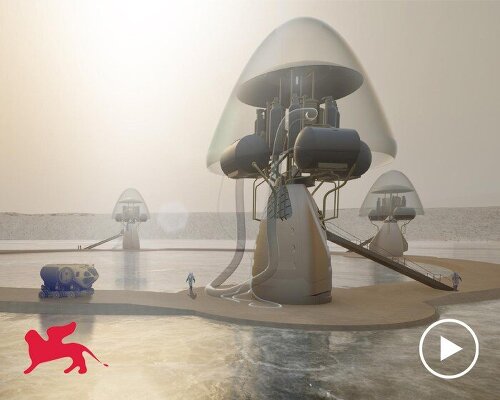mars hydrosphere by clouds is a merchant city on mars
At the 19th Venice Architecture Biennale, amid reflections on climate crisis, displacement, and dwindling resources, Clouds Architecture Office offers an otherworldly proposal for an underwater settlement on Mars. Mars Hydrosphere joins the main exhibition at Corderie dell’Arsenale, speculating a symbiotic city for 10,000, which draws on the properties of water — abundantly found on Mars and an effective shield against radiation. Submerged within a vast water reservoir, a necessity for sustaining life, the new city is composed of tensile inflated domes made from transparent film and fiber cables imported from Earth, and structural elements fabricated from 3D-printed local regolith.
The project builds on popular, ongoing imaginations of interplanetary migration to Mars. ‘Companies are actively developing rocket-based transportation systems, some with the goal of moving a million people to Mars. But where will they live?’ question the architects. As a result, the project transforms a Martian crater into both dwelling and life-support system in the water, with the architecture itself forming a hybrid: drawing on terrestrial engineering know-how while adapting to the constraints and material possibilities of in-situ Martian production.
image by Luca Capuano, courtesy of La Biennale di Venezia
a speculative aquatic commons at venice architecture biennale
The crater’s elevation and geological clarity suggest a promising presence of subsurface ice which is an essential resource, both for sustaining life and for structuring the architecture itself. It also forms the perfect location for a migratory spaceship to drop off new residents of the merchant city on Mars. Clouds Architecture Office imagines this reservoir as the literal ground for a new kind of city that is suspended just five meters beneath the surface, with the water performing multiple roles at once: it thermally insulates, shields against cosmic radiation, and, more conceptually, binds the settlement into a shared commons.
For the architects, the project works with the harsh environment and its limited natural material palette to create a settlement that sensitively adapts to the terrain. Within the core, sealed, pressurized dome — held at a breathable 1.0 atmosphere — the settlement creates a conditioned ‘bubble’ where public life unfolds. Its submerged location offers both physical protection and psychological continuity, and the water, transparent and vast, becomes a liquid sky above the city. It diffuses sunlight into the interiors and preserving circadian rhythms that would otherwise falter under Mars’ days and nights. This would not help maintain circadian rhythms and mental wellbeing, while increasing functionality and productivity for residents.
Clouds Architecture Office proposes an underwater settlement on Mars | image courtesy of Clouds Architecture Office
Inside, the domes follow a formal logic dictated by pressure and material behavior. Each dome spans 400 meters in diameter, pushing the limits of catenary geometry while maintaining a low 25-meter profile, a shape calibrated by the physics of underwater balance. The architecture organizes itself around a central compression ring, an inflated beam that stabilizes the enclosure, and is anchored to the Martian floor by repurposed transport rockets. These vertical structures then double as circulation shafts and infrastructural cores, rooting the floating city to the crater bed while supporting life above.
Though Mars Hydrosphere is first a survival scenario, it also forms an architectural proposition centered on the values of water as a medium. In doing so, it reframes resource use as an active design material. The reservoir’s saline composition, held in a pressurized state, reflects the Martian reality of phase shifts and freezing points, while desalination pods convert this body into drinkable water, filtered for human consumption. Waste heat from the city is also utilized to warm the reservoir.
image by Luca Capuano, courtesy of La Biennale di Venezia
image courtesy of Clouds Architecture Office
image courtesy of Clouds Architecture Office
image courtesy of Clouds Architecture Office
image courtesy of Clouds Architecture Office
image courtesy of Clouds Architecture Office
project info:
name: Mars Hydrosphere
architect: Clouds Architecture Office | @clouds_ao
location: Corderie dell’Arsenale, Venice, Italy
program: Venice Architecture Biennale | @labiennale
dates: May 10th — November 23rd, 2025
project designer: Ostap Rudakevych, Masayuki Sono, Maria Clara Machado
structural engineer: Jun Sato, The University of Tokyo + Jun Sato Structural Engineers Co Ltd
technical collaborator: Joseph Dituri PhD (University of South Florida), Kevin Kempton (NASA Langley Research Center), Kirby Runyon PhD (Planetary Science Institute), Luca Gamberini (Nemo’s Garden)
Jeffrey Montes (Blue Origin), Stefan Harsan Farr (identityplus), Jared W. G. Atkinson, PhD (Impossible Sensing Energy Inc)
The post clouds architecture office imagines an underwater merchant city in mars for venice biennale appeared first on designboom | architecture & design magazine.

